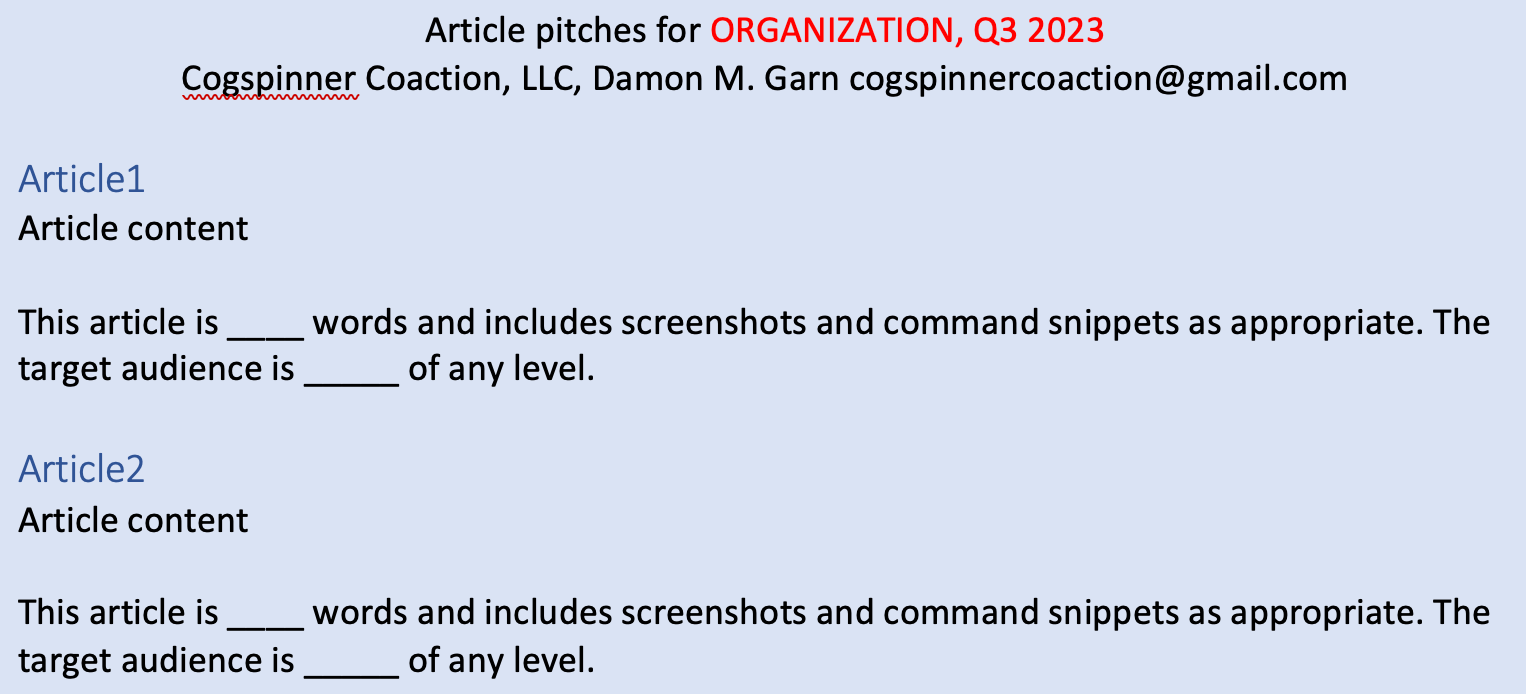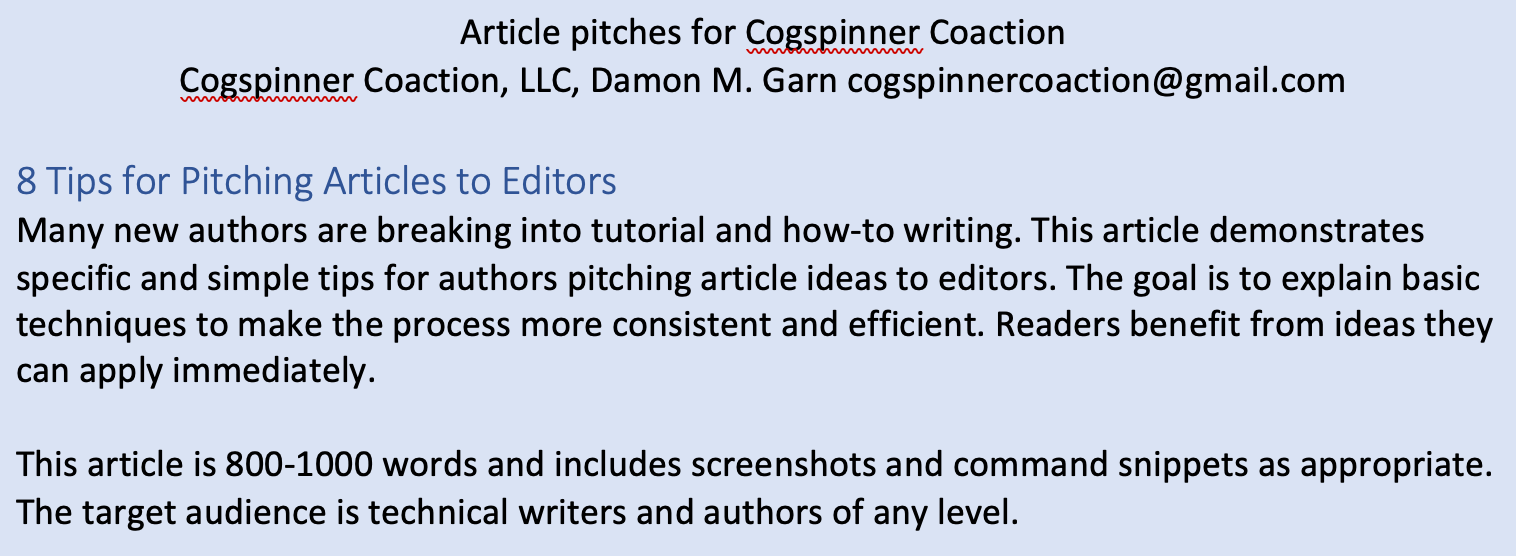 8 tips for pitching articles to editors
8 tips for pitching articles to editors
Pitching article ideas to publishers is critical to a successful writing business.
I struggled with pitching articles to editors for a long time before finally dedicating some energy to establishing the best process. I want to share my thoughts with all the potential authors out there.
One essential aspect of my business is writing informative, tutorial-style articles for the IT industry. I contribute to many online publishers, and I've fine-tuned my approach to pitching. Your pitching goal should be to make it easy for the editor to say yes.
Here are a series of tips for effectively and efficiently pitching article ideas to editors. Read to the end to find a sample pitch for this article!
1. Learn the publication's cadence
It may take some time, but learn the publication's cadence and organization. One of my key customers organizes their budget and schedule on a quarterly basis. I've learned to approach them with ideas just before a new quarter begins. Find out if the publication does collections of similar articles and pitch to those. For example, I was assigned five articles on Linux backup tools as part of a single collection in the summer of 2023.
Once you've submitted a few well-polished articles on time, remember to ask for other contacts within the company for whom you can write.
2. Provide the why and context
Give the editor background information on why the content is essential and unique. Provide context around the subject, especially if it's a critical topic that isn't prevalent in the news. It's easier for the editor to accept the piece if they understand who their readers will be and why those readers care about this subject.
3. Your outline becomes your pitch
My pitches are a summary of my article outline. I rarely have a fully developed outline when I make the pitch, but I always have a general idea of the article's structure. This allows me to estimate the word count and the effort I'll need to invest—all tied to the article's cost. In some cases, I've identified topics that should become two articles for readability and efficiency.
Estimating your effort is critical. I defeated myself with a few early pitches that were not well thought out. I proposed topics that I thought would be straightforward but turned out to be extremely difficult and time-consuming. Those topics are fine but be sure to plan time for them.
4. Schedule follow-ups
Create a follow-up calendar. Editors are busy folks! You may recognize the brilliance of your idea but other pitches flow across their desks daily. You might get lost in the shuffle, so don't hesitate to reach out a few weeks later to ask whether they are interested in your pitch. Just don't bug them by following up too soon.
You're also busy, so calendar reminders help you keep track of your queries.
5. Provide the details
Remember to provide relevant details. My pitches include one to two short paragraphs describing the topic, providing context, and explaining why it's important. I am also careful to include a paragraph estimating the word count and target audience. Finally, I remind the editor that I provide screenshots and command snippets. You could include the cost here, too.
Here's an example:

The goal is to make it easy to say yes.
6. Use a pitch template
I view pitching as unbilled hours (though I recognize the work pays off later). I need the pitching process to be as efficient as possible, so I created a template in Microsoft Word. It includes title headers and sample language (such as word count and target audience). All I must do is fill in the details. I place my contact information and date at the top, too.

Pitch templates keep your queries consistent and easy to read.
7. Track your pitches and avoid repeats
Develop a tracking system for your pitches. I badly embarrassed myself some years ago by resending a series of pitches to an editor a few months after the initial query. She replied that she'd already declined these ideas and wanted to know why I wasted her time resending them.
I use Microsoft Excel to manage my pitches. I will write a separate article with details on pitch tracking in the future. For now, ensure you have some method of avoiding repeated queries to the same editor.
Remember to track accepted articles!
8. Articles are not rejected; they are declined
I've periodically dabbled in writing fiction, and some years ago, I learned a great mental trick. Upon being down and frustrated over a good story being rejected multiple times, a fellow author suggested a change in terminology. Pieces are not "rejected" but rather "declined." This term is gentler and more accurate. When an editor declines a piece, it may not be a reflection of that article's quality. Instead, it indicates the piece isn't a good fit for the publication at the moment.
Not only does that word change help maintain your enthusiasm, but it reminds you to submit the pitch to other editors, where it may fit better with their current initiatives.
Making a great pitch
It goes without saying that you should check your pitches for spelling and grammar. This may be the editor's first exposure to your work.
Pitching article ideas to publishers is critical to a successful writing business. I hope the above tips provide you with approaches you can apply to your own writing endeavors. Please comment with your own pitching tips.
Here is a sample pitch for the article you just read.

